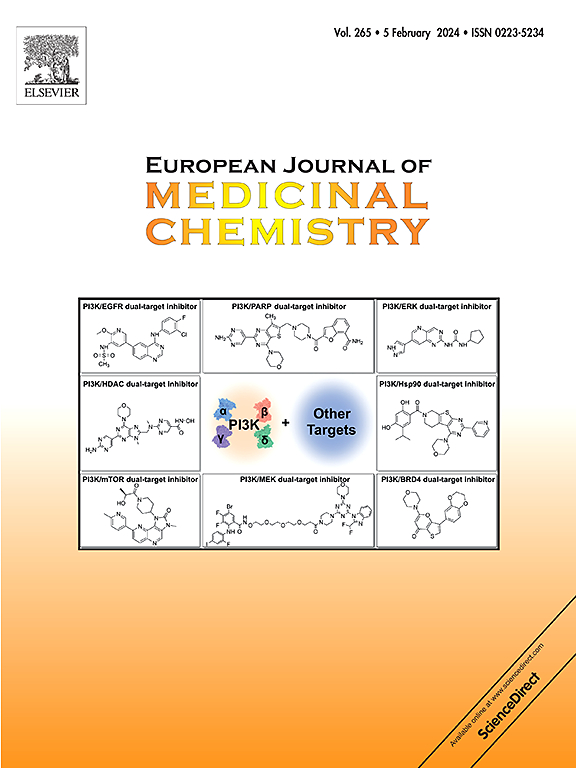新型抗癫痫Kv7.2/7.3活化剂5,7-二甲基苯并[d]噻唑的设计、合成及构效关系
IF 6
2区 医学
Q1 CHEMISTRY, MEDICINAL
引用次数: 0
摘要
神经元Kv7通道的激活由于其调节神经元兴奋性的作用而成为癫痫的重要治疗策略。雷沙滨(RTG)是一种Kv7.2/7.3通道激活剂,此前被批准用于癫痫治疗,但因其眼科和皮肤病色素沉着的副作用于2017年被撤销。尽管遭遇挫折,Kv7.2/7.3通道仍然是抗癫痫药物(aed)开发的一个有希望的靶标。先前的研究将毒性代谢醌/氮杂醌二亚胺和相关的RTG蓝色变色归因于其富电子的三胺芳香支架。减轻这种毒性的常见策略包括去除RTG的邻苯胺部分。在本研究中,我们设计并合成了一系列以二甲苯杂环支架为Kv7.2/7.3活化剂的化合物。其中,化合物2c在Rb+外排实验中表现出更好的疗效,在Kv7.2/7.3通道的全细胞膜片钳记录中也表现出相当的活性。此外,化合物2c对最大电击发作(MES)和皮下戊烯四氮唑(sc-PTZ)小鼠模型均有效,ED50值分别为4.02 mg/kg和43.17 mg/kg。急性毒性实验中2c对小鼠的LD50值为340.35 mg/kg (95% CI: 293.68 ~ 394.45)。此外,2c表现出运动障碍,在野外试验中TD50为48.93 mg/kg,在旋转试验中为49.25 mg/kg。化合物2c具有良好的药代动力学(PK)性能和血脑屏障(BBB)渗透性,并具有良好的光稳定性。位点定向突变结合分子对接证实了2c与Kv7.2通道中的关键残基(W236、F305和L299)相互作用。我们的研究结果表明,化合物2c是一种具有新型支架的先导化合物,可作为Kv7.2/7.3激活剂用于癫痫治疗。本文章由计算机程序翻译,如有差异,请以英文原文为准。
![Design, synthesis, and structure-activity relationship of 5,7- dimethylbenzo[d]thiazoles as novel Kv7.2/7.3 activators with antiepileptic effects](https://img.booksci.cn/booksciimg/2025-4/102303375121776642566.jpg)
![Design, synthesis, and structure-activity relationship of 5,7- dimethylbenzo[d]thiazoles as novel Kv7.2/7.3 activators with antiepileptic effects](https://img.booksci.cn/booksciimg/2025-4/2025042310231139892416.png)
Design, synthesis, and structure-activity relationship of 5,7- dimethylbenzo[d]thiazoles as novel Kv7.2/7.3 activators with antiepileptic effects
The activation of neuronal Kv7 channels has emerged as an important therapeutic strategy for epilepsy due to their role in regulating neuronal excitability. Retigabine (RTG), a Kv7.2/7.3 channel activator, was previously approved for epilepsy treatment but was withdrawn in 2017 because of its side effects of ophthalmological and dermatological pigmentation. Despite this setback, Kv7.2/7.3 channel remains a promising target for the development of antiepileptic drugs (AEDs). Previous studies have attributed the toxic metabolic quinone/azaquinone diimines and associated blue discoloration of RTG to its electron-rich tri-amine aromatic scaffold. A common strategy to mitigate this toxicity involves removing the ortho-aniline moiety of RTG. In this study, we designed and synthesized a series of compounds based on dimethylbenzene heterocyclic scaffolds as Kv7.2/7.3 activators. Among them, compound 2c demonstrated improved efficacy in Rb+ efflux assays and exhibited comparable activity in whole-cell patch clamp recordings on Kv7.2/7.3 channels. Moreover, compound 2c was effective in both maximal electroshock seizure (MES) and subcutaneous pentylenetetrazol (sc-PTZ) mouse models, with ED50 values of 4.02 mg/kg and 43.17 mg/kg, respectively. The LD50 value of 2c in acute toxicity experiments was 340.35 mg/kg (95 % CI: 293.68–394.45) in mice. Additionally, 2c exhibited locomotor impairment with at TD50 of 48.93 mg/kg in an open field test and 49.25 mg/kg in a rotarod test. Compound 2c also demonstrated reasonable pharmacokinetic (PK) properties and blood-brain barrier (BBB) penetration, along with good photostability. Site-directed mutagenesis, combined with molecular docking, confirmed that 2c interacted with key residues (W236, F305, and L299) in the Kv7.2 channel. Our findings suggest that compound 2c is a promising lead compound with a novel scaffold as a Kv7.2/7.3 activator for the management of epilepsy.
求助全文
通过发布文献求助,成功后即可免费获取论文全文。
去求助
来源期刊
CiteScore
11.70
自引率
9.00%
发文量
863
审稿时长
29 days
期刊介绍:
The European Journal of Medicinal Chemistry is a global journal that publishes studies on all aspects of medicinal chemistry. It provides a medium for publication of original papers and also welcomes critical review papers.
A typical paper would report on the organic synthesis, characterization and pharmacological evaluation of compounds. Other topics of interest are drug design, QSAR, molecular modeling, drug-receptor interactions, molecular aspects of drug metabolism, prodrug synthesis and drug targeting. The journal expects manuscripts to present the rational for a study, provide insight into the design of compounds or understanding of mechanism, or clarify the targets.

 求助内容:
求助内容: 应助结果提醒方式:
应助结果提醒方式:


